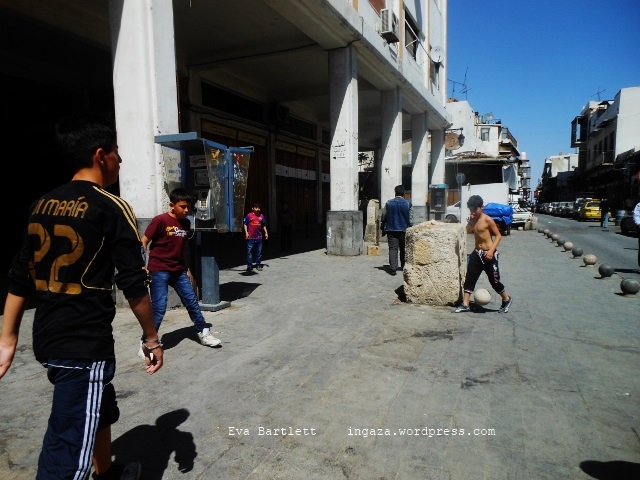On a weekday afternoon, the Old City of Damascus heaves with people, cars, motorcycles, bikes. Markets are full, buyers barter with merchants for the heaps of spices, Jasmine and other flowery perfumes, clothing, and most things one needs, abundant in the Hamidiyeh market.
At the end of the historic Roman Via Recta (Straight Street), boys play football amidst new and ancient columns. Vendors outside the old city call out their wares to busy streets.
Syria, in its fourth year of a devastating foreign-backed and armed attempt to overthrow the government, is somehow still pulsing with life and hope.
In the narrow, twisting back lanes of the Old City, couples walk hand in hand, older men greet each other with broad smiles and a kiss on each cheek. Music wafts from open doors of ancient homes, their courtyards bursting with greenery. A milkman delivers milk from large tins strapped to his bicycle.
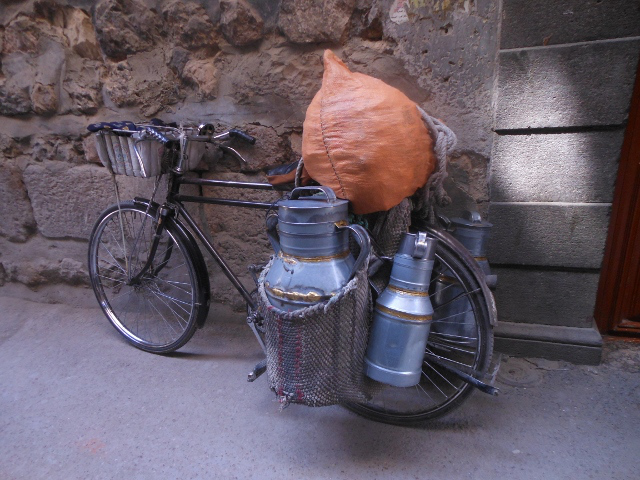
But the numerous, spacious old homes converted into hotels or restaurants, now have no tourists. Various shop owners highlight the same issue: they have goods, but no buyers.
Bassam runs his family’s antiques and jewelery store, Giovanni, near the East Gate entrance to the Old City, in an old Damascene home with vast arches, timber ceilings, and ornate wooden decor.
“Business is not very good, because of the situation. Many people used to come here.” Pointing out the now sparsely-stocked store, he says “One piece, one carpet, no gold. It was full of goods before.” He picks up a framed photo of himself and a woman in his store. “That’s Catherine Deneuve, a French actress. She’s very famous,” he says, reiterating that well-known people from around the world used to frequent his store, frequent Syria.
Inside the ornate Umayyad Mosque, worshipers pray and relax in the cool interior, a boy dances through the mosque, twirling Sufi-style. Outside, women sit in the courtyard shade with their children, picnicking on sandwiches.

The vast square opposite the mosque is packed with food vendors, clothing vendors, families milling about, kids selling roses. Children gather around a horde of pigeons, buying feed to toss to them.
A popcorn vendor in his twenties says things are improving in Syria. “Life here is good, things have gotten back to normal, the government supports us. But my house is in Babbila, just outside of Damascus. I can’t go back there, the ‘rebels’ have taken over there.”
Almost daily, armed groups launch mortars on civilian areas in Damascus, from villages on the outskirts like Jobar, Mliha. On April 15, these mortars struck Manar elementary school, killing a child and injuring 62 more. A kindergarten was also shelled the same morning, in the same densely-inhabited Christian area of Damascus, injuring three more children. On April 29, the mortars struck Bader Eddin al-Hassni Institute for religious science, killing 14 students and injuring 86 others, according to Sana news. (see: Children injured by mortars)
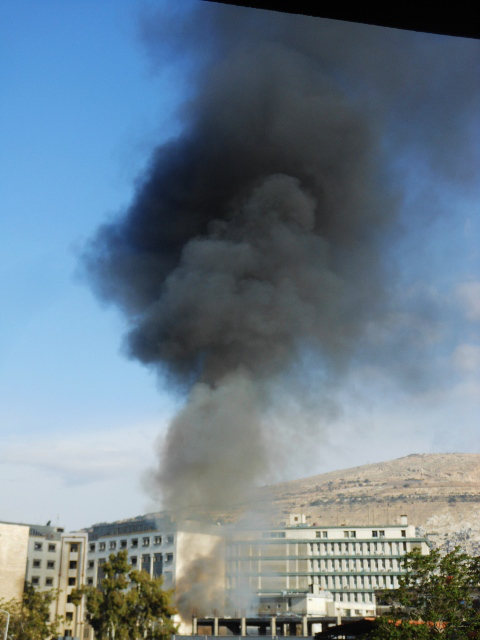
As I sit outside the old city walls one afternoon, roughly one hundred metres from East Gate, bullets whiz closely past, coming from the direction of Jobar, an area controlled by armed groups. (see: Not only mortars, but gunfire too, on Damascus)
Al-Midan, a district of Damascus known for its traditional Syrian sweets, still has local customers but faces the same loss of foreign customers as most in the tourism industry. “I used to bring delegations here specifically for the sweets,” says Anas, a journalist with Syrian television. “But as you see there are no tourists here now.”

Nagham, a university student, says even many local Syrians won’t go to Midan now. “People are afraid to come here now, because its so close to Yarmouk. Midan is safe, but people think that the ‘terrorists’ in Yarmouk will fire mortars here.”
A school in Zahara neighbourhood of Damascus has been converted into a shelter for displaced Syrians and Palestinians from Yarmouk. The children shine with bright smiles, the adults have tales of sorrow from their experiences and from being displaced by the snipers and other attacks by the armed gangs. They all say the same thing: “The rebels, those terrorists, came into Yarmouk, we had to leave.”
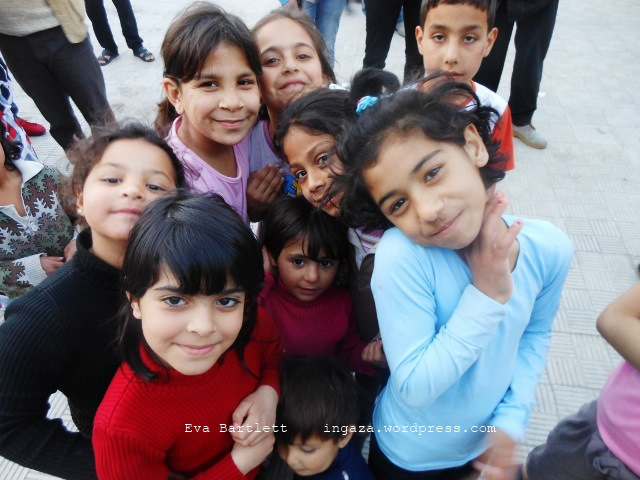
Their accommodations are sparse (there are so many displaced from various areas of Syria that accommodations become overcrowded), but the UN-provided accommodation is far worse, with rooms overcrowded with up to 25 or more people who sleep mattress to mattress for over one year. “We’re like sardines here,” says one displaced woman. “They keep piling more people upon us.”
Due to attacks on civilians, like car bombings, checkpoints are installed throughout Damascus and the countryside, causing long lines of traffic as soldiers check vehicles for explosives. But without the checkpoints, there would be more loss of civilian life.
Homs residents know too well the deadly effects of the car-bombings. On April 9, for example, two car bombs detonated one after the other on the same residential street, killing 25 civilians, injuring over 107 more, according to Syrian state media. On April 29, two more car bombs and a rocket attack killed another 42 civilians in Homs. (see: Civilian areas in Homs and Damascus car-bombed and shelled Tuesday)
But Homs is also a place where the reconciliation movement has taken flight, with fighters nearly daily laying down their weapons and opting for a political solution for Syria.
In Latakia, a coastal city roughly 350 km northwest of Damascus, near the Turkish border, internally displaced Syrians from the Armenian village of Kasab take refuge in an Armenian Orthodox Church.
On March 21, armed groups began firing missiles from nearby Turkey upon the village, later entering and taking it over, committing atrocities against the civilians. Eighty people are reported to have been killed, and nearly 2000 villagers fled to Latakia and other areas to escape the attacks by a reported1500 Chechnyan and other foreign, al-Qaeda-affiliated insurgents, backed by Turkish special forces.
“The mercenaries used pick-up trucks fitted with anti-aircraft weapons, tanks belonging to the Turkish Armed Forces, vehicles loaded with heavy weaponry and lorries,” journalist Cem Ertürreported in his detailed and well-documented “NATO and Turkey’s Genocidal War on Syria.”
“They can destroy our houses, it’s alright, but we’re going back, and taking Kasab back. By the army, because we believe in the Syrian Arab Army,” said Suzy, from Kasab, who also described some of the atrocities committed. “They raped the older women, because they couldn’t find girls, so they raped the elderly. They destroyed everything, they robbed our houses, they broke the cross, broke the statue of the Virgin Mary, threw it on the ground.”(see also: Horrors from Haram, Nobbul, Zahra)
When asked her sentiments on Syria’s President, Suzy spoke without hesitation, like so many others in Syria. “We have a leader, Dr. Bashar Al-Assad. We love him so much, we don’t want anything else. We want him, we want Syria back.”
Vani, a young television broadcaster in Damascus, spoke of Kasab and her freedoms as an Armenian-Syrian.
“I’m a Syrian citizen and I’ve never felt oppressed. I’m an Armenian-Syrian, we have schools, we learn the language, we have churches, theatres. We have scouts groups, we used to camp in Kasab every summer. Right near the Turkish borders. We had all the freedom to do our rituals. But I wouldn’t go to Kasab now, there are armed groups there.”
Elsewhere in Latakia, a city secured by the Syrian army but attacked from a distance with missiles, children and teens play in a fountain in a large, clean park, and men and women sit smoking shisha or hookah and chatting.
Fadia, an unveiled Sunni Muslim, sitting with a group of veiled and unveiled women, says that internally Latakia does not have serious problems. “Life is good here, we’re living happily, the army have protected us here. We love our president, our army, our country, but the outside forces want to destroy the country. There is no problem between Christians, Muslims, Armenians, Alawites here. We are all one family, no one can split us apart.”
This is a point Lilly Martin, who is from California but has lived in Syria for the past 22 years, drives home. (see conversation with Lilly Martin)
“At the beginning, we had a surge of violence, protestors attacking Syrian police and security, but right away the Latakian people turned against it. The population here didn’t accept it. We have Christians, Muslims, and minorities here. There is very little support for the ‘rebels’ here, so it’s been a peaceful city,” she says.
While the armed groups haven’t successfully established themselves in Latakia, they do however attack the city from afar. “Here in Latakia, we are still getting hit by missiles from those same terrorists along the Syrian –Turkey border,” Martin says. “They load the missiles, shoot them off, then run away.”
These armed groups, terrorists as they are generally known in Syria, have also taken over and looted as many as 1500 Aleppo factories, their goods taken to Turkey.
While the government subsidizes bread and provides free health care and university education, the attacks of the past few years have devastated the economy; many farming and factory areas are inaccessible due to the presence of the armed groups.
These factors, and the sanctions unjustly imposed on Syria, are some of the reasons that more and more Syrians find themselves depending on financial aid from relatives abroad, largely via Western Union since most foreign banks are now inaccessible in Syria. At 2 p.m., a Western Union office is packed with those waiting to receive funds, most of whom waiting since 9 a.m. The same scene plays out at Western Union offices throughout Damascus. An imperfect transaction system is worsened by the number of people needing to receive money.
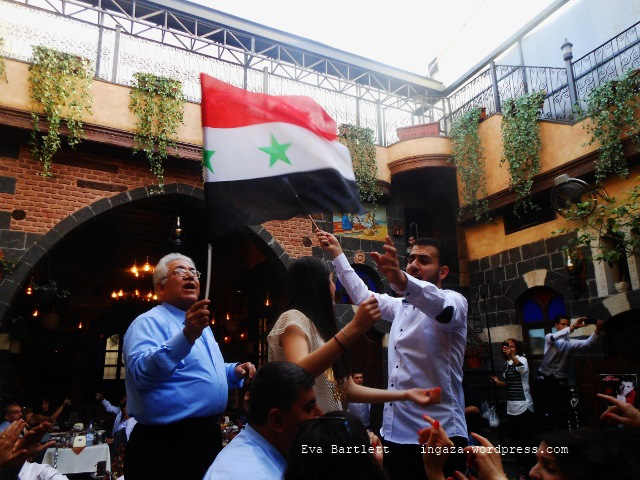
In Homs, Latakia, Damascus, walls and shop doors are decorated with large, painted replications of the Syrian flag and posters of President Assad. Syrian flags appeared at Easter celebrations, wedding and engagement parties. With the flags, patriotic songs for Syria and for President Assad, a roomful of celebrants singing along, hooting, clapping. (see: Homs supporters and Easter celebration despite sordid realities, and other snippets from Syria)
On the Autostrad, the main street leading to al-Mezze district of Damascus, a block-long mural brightens the otherwise standard wall surrounding a school. The colourful mosaic of scraps of tiles and recycled items is the project of six artists. Moaffak Makhoul, the lead artist, explains the concept. (see: Interview with Moaffak Makhoul, co-creater of Guinness record breaking wall mural in Damascus)
“We did this for the children, to bring a smile to their faces. And we wanted to send a message to the world that we Syrians love life, and that we insist to live, to survive,” he says.
His message also has an important political element to it. “To the ideology that wants to eliminate others, the Takfiri ideology, we tell them ‘no’.”
Four youths in their late teens pass by and stop to talk. “We were living well, with security, before this happened. We were living in freedom. Now we’re not,” Rehab, one of the girls, says. “Now, no, you don’t know who is a terrorist. We just want our country to return to how it was.”
Ramez, one of the four, says things are better now, “life is improving.” Batoul, the other girl, adds “We love Bashar. He’s a good person. We know what he has done to improve the country. And before any of these things began, we were living well, in security.
Bassam, in his lonely East Gate store, is also optimistic. “Peace is coming sooner or later. Sooner. Damascus is a wonderful city. And the people are wonderful also.”
The call to prayer sounds, church bells ring out, in a city and country still living despite it all.
All images courtesy Eva Bartlett

